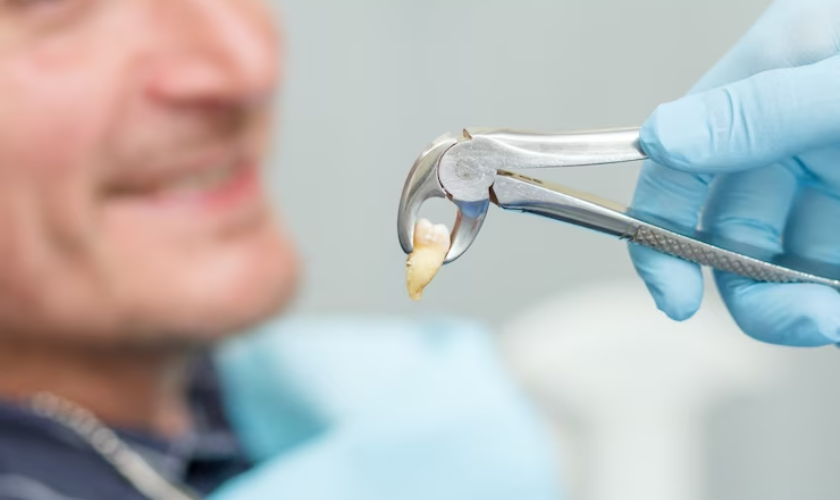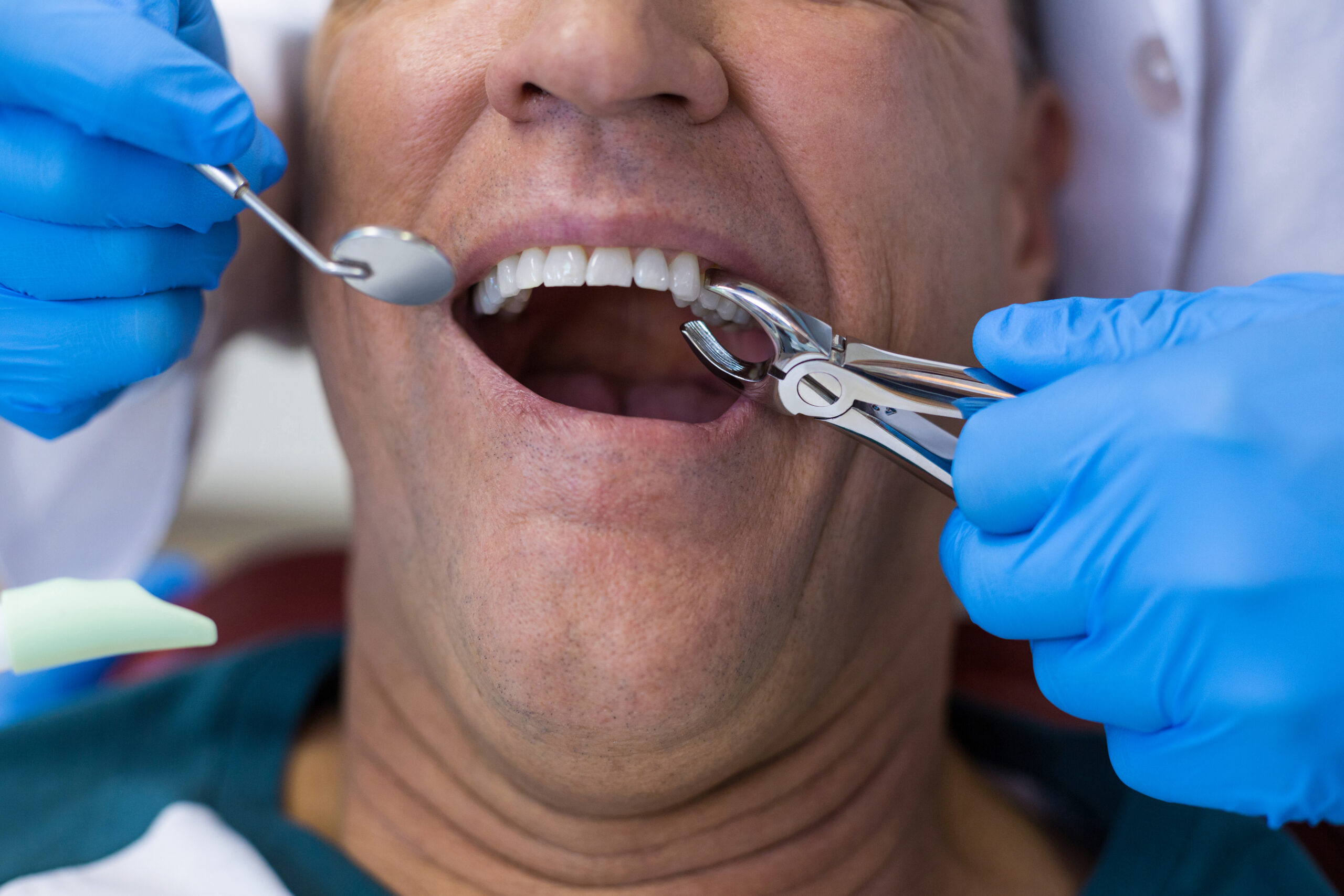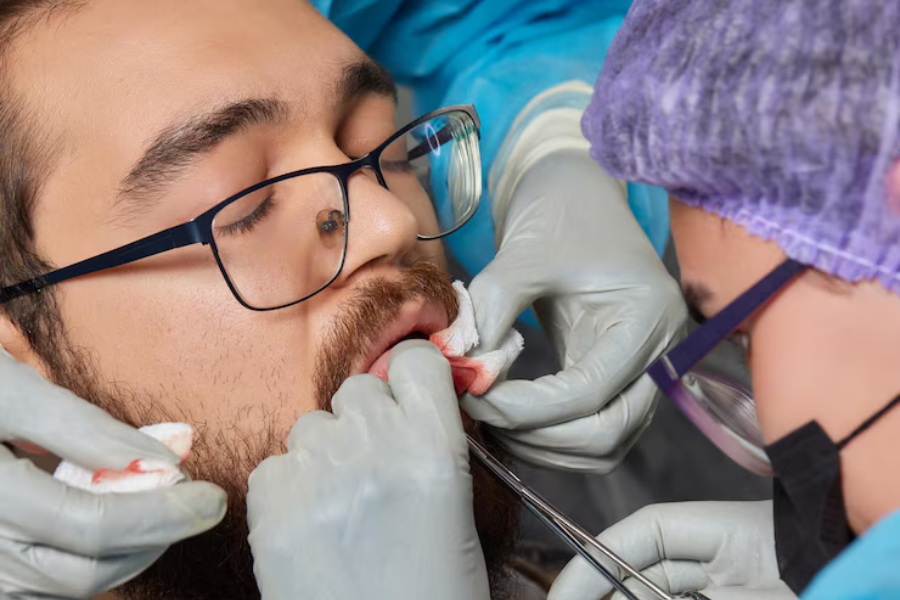We are not a registered Medicare/Medicaid Provider
Following A Tooth Extraction, What Should I Do?

A tooth extraction is a common dental procedure performed to remove a damaged, decayed, or problematic tooth. While the procedure itself is relatively straightforward, proper care after the extraction is essential for healing and preventing infection. After undergoing a tooth extraction, proper care is essential for ensuring a smooth recovery and preventing complications. Whether you’ve had a simple extraction or a surgical procedure, following your dentist’s instructions is crucial. Here’s a comprehensive guide on what to do after a tooth extraction.
Immediate Post-Extraction Care
Right after your tooth extraction, your dentist will provide you with detailed instructions to ensure proper healing and minimize discomfort. Here’s what you can expect and how to manage it:
Biting on a Gauze Pad
After the extraction, your dentist will place a gauze pad over the extraction site. You should gently but firmly bite down on this pad for about 30-45 minutes. This pressure helps to reduce bleeding by allowing a blood clot to form in the empty tooth socket. It’s crucial to follow this step to prevent excessive bleeding and promote proper healing.
Managing Pain
It’s common to experience some discomfort after a tooth extraction. Your dentist may prescribe pain medication, such as ibuprofen or acetaminophen, to help manage the pain. If you’re prescribed medication, make sure to take it as directed. Over-the-counter pain relievers can also be effective in managing mild to moderate pain.
Applying Ice Packs
Swelling is also common after a tooth extraction. To reduce swelling and alleviate pain, you can apply an ice pack to the outside of your face near the extraction site. Wrap the ice pack in a thin cloth and apply it to the affected area for 10-20 minutes at a time. Make sure to take breaks between applications to prevent skin damage.
Avoiding Certain Activities
In addition to avoiding physical activity, you should also avoid certain activities that can disrupt the healing process. These include smoking, drinking through a straw, and spitting excessively. These actions can dislodge the blood clot that forms in the extraction site, leading to a painful condition called dry socket.
Eating and Drinking
After having a tooth extracted, it’s important to eat soft foods and steer clear of hot or spicy items that could cause irritation at the extraction site. Stay hydrated by drinking plenty of fluids, but avoid using a straw, as the sucking action could dislodge the blood clot. As you start to feel more comfortable, slowly reintroduce solid foods into your diet.
Oral Hygiene
Keeping the extraction site clean is crucial for preventing infection. However, you should avoid brushing near the extraction site for the first 24 hours. After 24 hours, you can gently brush the area with a soft-bristled toothbrush. Rinse your mouth with warm salt water after meals to keep the area clean and promote healing.
Managing Pain and Discomfort
Here are some additional tips to help you feel more comfortable:
Follow Pain Medication Instructions: Your dentist might prescribe pain medication to alleviate any discomfort. It’s important to adhere to the prescribed dosage, even if you start feeling better, to effectively manage pain.
Apply Ice Packs: Placing an ice pack on the outside of your face close to the extraction area can help decrease swelling and numb the region, offering relief from pain. Be sure to wrap the ice pack in a cloth or towel to prevent skin damage.
Elevate Your Head: Keeping your head elevated while lying down can help reduce swelling and discomfort. Use an extra pillow to prop up your head and upper body while sleeping.
Eat Soft Foods: Stick to a soft diet for the first few days after your extraction. Foods like mashed potatoes, yogurt, and smoothies are easy to eat and won’t irritate the extraction site.
Avoid Smoking and Alcohol: Smoking and alcohol can delay healing and increase the risk of infection. Avoid these substances until your dentist gives you the all-clear.
Rinse with Salt Water: After having a tooth extracted, it’s important to rinse your mouth with warm salt water several times a day. This helps to reduce swelling and prevent infection. Simply mix half a teaspoon of salt into a glass of warm water, swish it around your mouth for about 30 seconds, and then spit it out.
Use a Cold Compress: If you’re experiencing swelling or bruising, applying a cold compress to the outside of your face can help reduce inflammation. Wrap a bag of frozen peas or a cold pack in a thin cloth and apply it to the affected area for 10-20 minutes at a time.
Eating and Drinking
After a tooth extraction, your diet plays a crucial role in your recovery. Here are some tips for eating and drinking after a tooth extraction:
Stick to Soft Foods: Opt for soft foods that are easy to chew and swallow. This includes foods like mashed potatoes, scrambled eggs, oatmeal, and steamed vegetables. Avoid foods that are hard, crunchy, or sticky, as they can irritate the extraction site.
Stay Hydrated: It’s important to stay hydrated after a tooth extraction. Drink plenty of water throughout the day to help with healing and prevent dehydration. Avoid using a straw, as the sucking motion can dislodge the blood clot and delay healing.
Avoid Spicy or Acidic Foods: Spicy or acidic foods can irritate the extraction site and cause discomfort. It’s best to avoid these types of foods until your mouth has healed completely.
Limit Sugar Intake: Sugary foods and beverages can increase the risk of infection and delay healing. Try to limit your intake of sugary foods and opt for healthier alternatives instead.
Gradually Introduce Solid Foods: Start by eating soft, easy-to-chew foods after your extraction. As you start to feel more comfortable, you can gradually introduce solid foods back into your diet. Be sure to chew carefully and avoid biting down directly on the extraction site.
Refrain from Alcohol and Tobacco: Alcohol and tobacco can disrupt the healing process and raise the chances of complications. It is advisable to steer clear of these substances until your mouth has completely healed.
Oral Hygiene
Avoid Brushing Near the Extraction Site
For the first 24 hours after your tooth extraction, it’s important to avoid brushing near the extraction site. This allows the blood clot to form and stabilize, which is essential for proper healing. After the initial 24 hours, you can gently brush the area with a soft-bristled toothbrush. Be careful not to brush too vigorously, as this can irritate the extraction site.
Rinse with Salt Water
Rinsing your mouth with warm salt water can help keep the extraction site clean and reduce the risk of infection. To make a saltwater rinse:
- Dissolve half a teaspoon of salt in a glass of warm water.
- Swish the solution around your mouth for about 30 seconds, then spit it out.
- Repeat this process after meals and before bed to keep the area clean.
Use a Mouthwash
Using an antimicrobial mouthwash can help reduce the risk of infection and keep your mouth feeling fresh. Look for a mouthwash that is alcohol-free and specifically formulated for post-extraction use. Rinse your mouth with the mouthwash according to the manufacturer’s instructions, usually twice a day.
Avoid Touching the Extraction Site
It’s important to avoid touching the extraction site with your fingers or tongue. This can introduce bacteria into the wound and increase the risk of infection. If you need to touch the area, make sure your hands are clean and sanitized.
Follow-Up Care
After a tooth extraction, proper follow-up care is essential for monitoring your healing progress and addressing any concerns. Here’s what you can expect during your follow-up appointments:
Monitoring Healing Progress: Your dentist will examine the extraction site to ensure that it is healing properly. They will check for signs of infection, such as redness, swelling, or pus. They will also evaluate the formation of a blood clot and the condition of the surrounding gums.
Removing Stitches: If stitches were placed during the extraction, your dentist may need to remove them during a follow-up appointment. This is typically done about a week after the extraction, but the timing may vary depending on the type of stitches used and the extent of the extraction.
Addressing Concerns: If you experience any unusual symptoms after your extraction, such as excessive bleeding, severe pain, or signs of infection, it’s important to contact your dentist immediately. They can provide guidance on how to manage these symptoms and may need to see you for an emergency appointment.
Providing Further Instructions: Your dentist may provide you with further instructions on how to care for your mouth after the extraction. This may include guidance on oral hygiene practices, dietary restrictions, and pain management techniques.
Ensuring Proper Healing: Following your dentist’s instructions and attending your follow-up appointments is crucial for ensuring proper healing. By closely following your dentist’s advice, you can help prevent complications and promote a smooth recovery.
Following proper care instructions after a tooth extraction is crucial for a smooth recovery and to prevent complications. By adhering to your dentist’s advice and maintaining good oral hygiene practices, you can promote healing and reduce the risk of infection. It’s important to follow the specific instructions provided by your dentist, such as how to manage pain, what foods to eat, and how to clean your mouth. These instructions are tailored to your situation and are designed to help you heal as quickly and effectively as possible.


